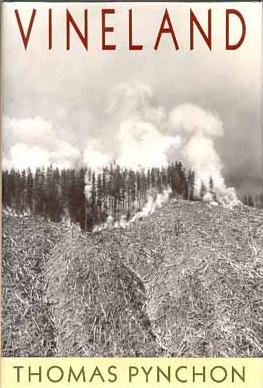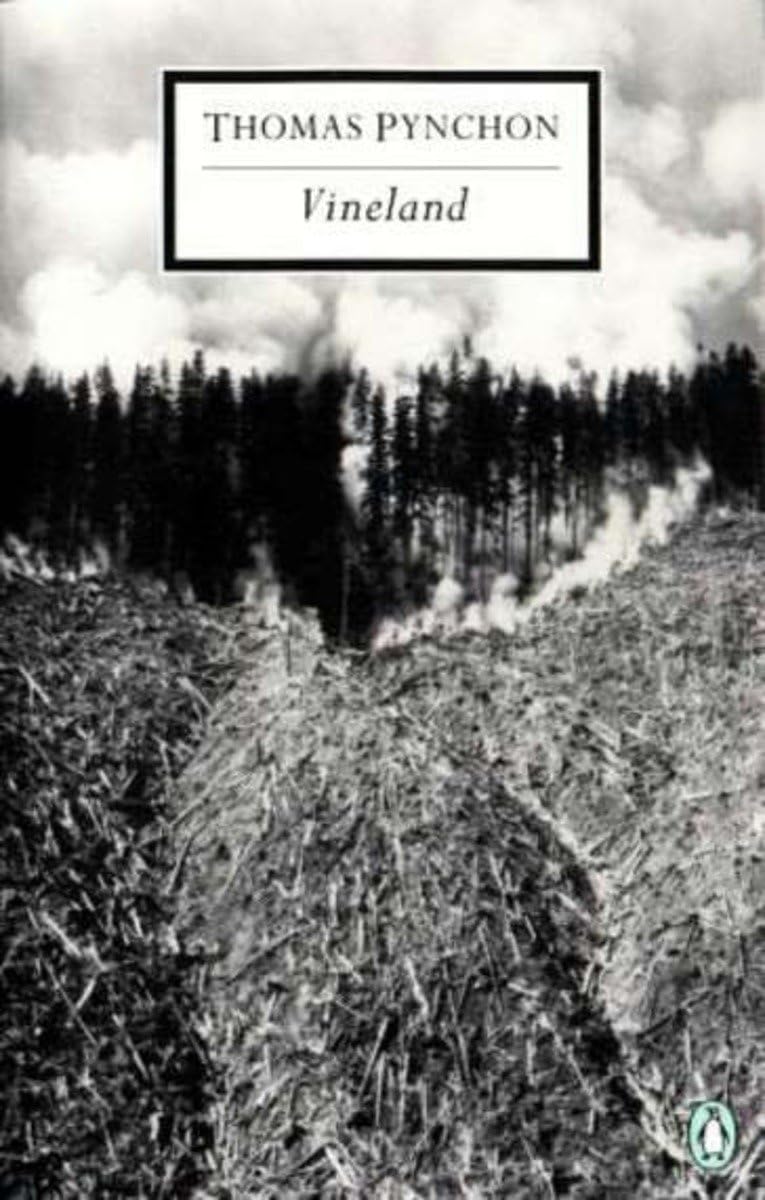Pynchon Works: “Vineland”
- At January 12, 2021
- By Spermatikos Logos
- In Pynchon, The Modern Word
 0
0
Vineland the Good
Thomas Pynchon’s Vineland
Vineland
Little Brown, 1990.
Little Brown, 1990.
Vineland
Penguin Classics, 1997.
Penguin Classics, 1997.
Few novels in the late twentieth century literary had been more eagerly anticipated than Vineland. Gravity’s Rainbow had taken people by surprise, and for good or ill, it was undeniably one of the Most Important Books of the Seventies, if not the latter half of the century. All eyes were on the reclusive Thomas Pynchon—what would he write next? And, as the years went by, excitement mounted: what would he write next, and why was it taking him seventeen years?! Rumor had it that he was writing a huge novel about the Civil War. Some said it was a novel about California. Others were expecting perhaps some sort of sequel to Gravity’s Rainbow.
What no one was really expecting was Vineland, a fairly short, essentially straightforward novel about an aging hippie and his free-spirited daughter. This was it?! was the anguished cry. Seventeen years for only 385 pages? Indeed, Vineland has achieved the dubious status of being Pynchon’s Most Maligned Work. It was a let-down, a disappointment; it didn’t live up to the promise of Gravity’s Rainbow; it was trivial, crammed with pop culture references and populated by unbelievable characters….
Bah, we say—Bah! Vineland is a small masterpiece, a truly great American novel that, while not as groundbreaking or expansive as Gravity’s Rainbow, is more focused and pointed that anything Pynchon’s ever written. It is humane, compassionate, funny and profound, and it says more about American culture than could a dozen copies of DeLillo’s White Noise and a few months of touring with the Grateful Dead. Vineland is among the best novels of the 1990s, and once you separate the sense of hyped-up disappointment from the novel as a thing-in-itself, a truly remarkable work is revealed, sparkling clearly in the California sun.
The story is set in the fictional town of Vineland, a redwood community nestled in a realismo-mágico California, a terrain already visited by The Crying of Lot 49. Vineland is a place where all currents of American life lazily intersect, where a sense of technological fetishization shares space with a rugged back-to-nature pioneering spirit, where the line between cults, communities, and extended families are blurred, and where money and power implicitly corrode the sense of freedom and liberty at the heart of the American dream.
The plot is fairly simple. Zoyd Wheeler is a single father, an old hippie doing his best to raise his free-spirited daughter, Prairie. He is still very much in love with his ex-wife, Frenesi, who left Zoyd and their young daughter many years ago, for reasons that slowly emerge as the novel takes shape. The story is set in motion when old ghosts from Zoyd’s previous life suddenly materialize in his idyllic world, precipitating a situation in which Prairie is forced to confront and understand her mother’s desertion. Like Stencil in V., Prairie sets off on a quest to find Frenesi, encountering some very unusual people along the way, each with their own story to tell. As Prairie gradually assembles the pieces of her mother’s jigsaw life, an image of an extended American family begins to form, three generations of a family at war with their society, their government, and themselves.
Though Vineland is one of Pynchon’s most accessible novels, it nevertheless has its own intriguing and ultimately rewarding complexities. As with all of Pynchon’s fiction, one cannot grasp the whole all at once, and Vineland is careful not to reveal things in a strictly linear fashion. Three generations and their many interconnections form quite a substantial narrative web, and for the most part, we are forced to construct the story along with young Prairie. A book that bears a second reading, not until the very end do we really see the Big Picture. Also typical of Pynchon’s writing, there are numerous stylistic pitfalls to snare the unwary: stories nested within stories, unpredictable leaps into fantasy, and a narrative point of view that tends to shift gears unexpectedly. In the end, however, Vineland emerges as a seamlessly crafted work, and like V. and Lot 49, one that allows a certain openness in the interpretation of key events.
Yet more so than narrative or structure, the complexity of Vineland lies in the emotional core of its subject matter. Of course, typical Pynchonian themes may be readily identified: the ambiguity of interpretation, the multifold nature of love, the relationship of the individual to power, and the effect of control upon individuals, both those who exercise it and its subjects. But more so than in any other work before Vineland, Pynchon deals with these issues with a greater clarity, wit, and compassion. The characters of Vineland are portrayed not in the black-and-white context of “Us vs. Them,” but are seen as morally complex human beings situated in an ambiguous network of power relationships. In Vineland, the forces of Us and Them are internalized, representing the collected weight of personal choices: two sides of the same coin, within every “Us” are the seeds of “They.” The best moments in the novel are when characters must confront the forces of compromise, belief, and regret that result from their various decisions, and Pynchon has never handled this with more poignancy and understanding. Even the government is decentralized to the point of invisibility, and while its power may be both omnipresent and malignant, it flows from person to person along the conduits of their own decisions.
If Vineland seems to suggest that Good and Evil are fictions of perspective, it does offer a small bridge across the moral vacuum in the form of community. While communities and families certainly come with their own systems of power, abuse, and control, they also bring love—at least with family, there is love; that power which in Pynchon is always transcendent.
Spermatikos Logos Resources
Vineland Criticism — Criticism and reader’s guides about Vineland.
Vineland Papers & Essays — Selected papers and essays about Vineland can be found here.
Offsite Resources
Babies of Wackiness: A Reader’s Guide to Vineland — Created by John Diebold and Michael Goodwin, this guide is now online at Yumpu.
Tim Ware’s Vineland Page — Information about Vineland at ThomasPynchon.com.
Selected Reviews
From the January 14, 1990 New York Times, Rushdie’s is a delightful and very positive review of an often maligned work.
A review for MIT’s The Tech, March 23, 1990.
Pynchon Works:
[Main Page | Short Stories | V. | Crying of Lot 49 | Gravity’s Rainbow | Vineland | Mason & Dixon | Against the Day | Inherent Vice | Bleeding Edge]
[Main Page | Short Stories | V. | Crying of Lot 49 | Gravity’s Rainbow | Vineland | Mason & Dixon | Against the Day | Inherent Vice | Bleeding Edge]
Authors: Allen B. Ruch
Last Modified: 31 August 2024
Main Pynchon Page: Spermatikos Logos
Contact: quail(at)shipwrecklibrary(dot)com
Last Modified: 31 August 2024
Main Pynchon Page: Spermatikos Logos
Contact: quail(at)shipwrecklibrary(dot)com



